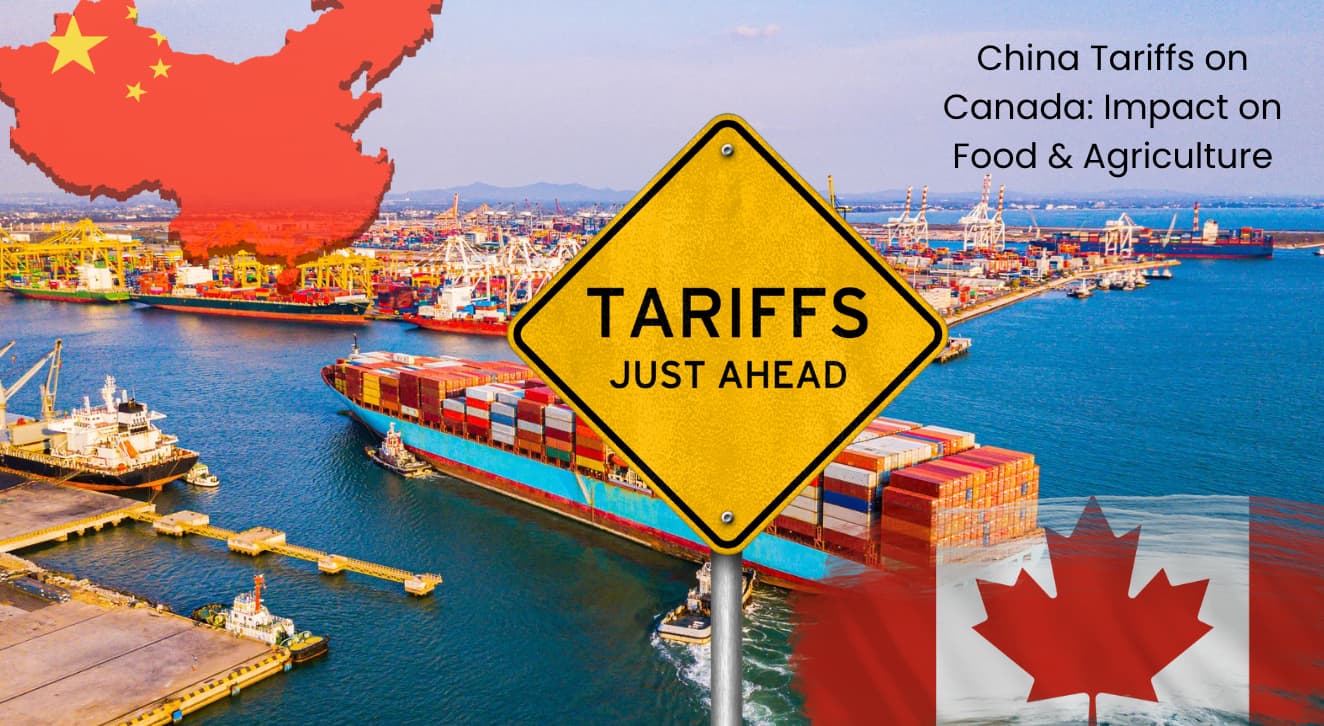China has set new tariffs on Canadian products, targeting canola oil, peas, pork, and seafood with duties as high as 100 percent. These tariffs took effect in March 2025 and directly impact many of Canada's top agricultural and food exports.
The move is a response to Canadian tariffs imposed on Chinese electric vehicles, steel, and aluminum in late 2024.
If you trade with China or buy Canadian food goods, these changes could have a significant impact on prices and market access.
Understanding why these tariffs were introduced, which products are affected, and what it could mean for your business helps you make better decisions in a changing global market.
Quick Insights ⚡:
- China tariffs on Canada hit key food and agriculture exports in 2025.
- China tariffs on Canada impact canola, pork, beef, and soybeans.
- Retaliatory measures follow Canada’s political stance on Huawei, Uyghurs.
- Canadian farmers face $2B+ in lost exports—must diversify markets.
- Potential long-term shift to EU, Mexico, and Southeast Asian buyers.
Why Did China Impose Tariffs on Canada in 2025?
China put new tariffs on several Canadian products in 2025. This move was a direct answer to Canada’s earlier tariffs on Chinese goods. These tariffs quickly raised tensions between the two countries.
The Political and Economic Backstory
China and Canada have had a rocky relationship for several years. Trade between them has often been influenced by bigger political issues, such as Canada’s close ties with Western countries and ongoing debates over technology and national security.
Even before the latest tariffs, both countries had a significant trade in products such as cars, steel, canola oil, and seafood.
In October 2024, Canada introduced new tariffs on certain Chinese goods, including electric vehicles, steel, and aluminum. China saw these new taxes as unfair and harmful to its businesses.
From China’s perspective, it appeared that Canada was attempting to protect its own companies while making it more difficult for Chinese products to compete.
Both countries depend on each other for essential imports and exports. However, Canada’s strong partnerships with countries like the United States gave it the confidence to take action, even if it meant upsetting China.
After the tariffs were announced, China began searching for ways to respond and show that it would not simply accept these new barriers.
Official Reasons vs. Real Motives
China said its new tariffs were a response to Canada’s trade actions. The official reason given was retaliation for the tariffs on Chinese electric cars, steel, and aluminum. Chinese officials claimed they were simply protecting Chinese companies and workers.
However, behind the scenes, there are deeper motives. The tariffs also showed China’s displeasure with Canada’s growing alignment with the US and Europe on trade. China may have also wanted to pressure Canadian farmers and businesses who depend on selling to China.
By targeting products like canola oil, peas, pork, and seafood, China chose industries where Canada stands to lose the most. This move was meant to hurt Canada’s exports while sending a clear message: if you restrict Chinese goods, China will respond with its own tough measures.
Timeline of Tariff Actions
Here is a quick timeline of the main events:
- October 2024: Canada announces new tariffs on Chinese electric vehicles, steel, and aluminum.
- March 8, 2025: China’s commerce ministry announces a 100% tariff on Canadian canola oil, oil cakes, and peas. There is also a 25% tariff on Canadian seafood and pork.
- March 20, 2025: China’s tariffs officially take effect. Canadian farmers and exporters are beginning to face higher costs and limited access to the Chinese market.
- In the weeks that follow, tension persists as both countries seek ways to manage the dispute without harming their economies too severely.
📌 Also Read: China Import Tariffs: Essential Guide for Importers
How Do "China Tariffs on Canada" Impact Agriculture and Food Products?

Tariffs imposed by China on Canadian goods impact farms, food producers, and trade partners.
Crop and seafood exports can incur additional costs, and some markets may dry up while others become more significant.
What’s on the List? Major Targeted Products
China has set tariffs or other trade limits on several Canadian farm and food items. The main products include:
- Canola seeds and oil
- Pork and other meats
- Soybeans
- Lobster and other seafood
These products are some of Canada’s top exports to China. For example, China is one of the biggest buyers of canola, but blocked some shipments in the past over quality claims.
Pork and soybeans have also faced import delays and extra checks, slowing down trade. Lobster exporters saw sales drop after new tariffs or restrictions made prices less competitive in the Chinese market.
How Hard Are Canadian Farmers Hit?
The tariffs have caused real problems for Canadian farmers and the food industry. Many have seen lower prices for their products, smaller sales, and higher storage costs.
In some areas, canola farmers had to keep their crops in silos longer due to canceled shipments.
Pork producers lost millions in export sales after China stopped buying over trade spats or health scares. Some small seafood businesses cut staff or reduced catch because demand in China fell.
You can see from the numbers that trade dropped sharply after tariffs were set. These losses impact not only farm families but also jobs in rural towns and shipping companies.
Trade Routes Rerouted—Finding New Markets
With stricter rules in China, Canadian exports have been sent to other countries. You might see more canola and pork sold to the European Union, Japan, and some new buyers in Southeast Asia.
Finding new markets is not easy. Different countries have their own food regulations and tastes, which means some Canadian products may require changes to packaging, permits, or even new trade agreements.
- Some countries pay less than China
- Shipping costs are higher to places like Europe
- Extra paperwork and health checks can slow things down
Still, some Canadian farmers and companies have found new buyers and set up new trade routes.
This takes time and does not fully make up for the lost Chinese market, but it helps reduce the risk of relying on any single country.
📌 Also Read: Russian Tariffs on China: List of Goods and Their Impact on Trade
How China's Tariffs on Canada Are Reshaping Agri-Food Trade

China’s tariffs on Canadian farm goods are causing big changes in the agri-food trade. These tariffs affect everything from what farmers can sell to which countries get a larger piece of the market.
Immediate Financial Losses for Canadian Farmers
Canadian farmers have faced a quick and heavy financial impact.
- Canola exports have dropped by over $2 billion since 2019 due to China’s restrictions.
- Large amounts of canola oil, peas, and oilseed meals now face tariffs of up to 100 percent.
- Pork exporters lost access to a key market almost overnight, causing excess supply and falling prices.
You see farmers dealing with lost income, unsold crops, and mounting storage costs. Many are changing what they plant to avoid more losses.
Some producers are relying on federal support, but the damage to the market is already done.
Who Benefits? Competitors Fill the Gap
Competitors in other countries quickly moved in to claim Canada’s lost market share.
- The United States and Australia expanded their sales of canola and beef to China.
- Brazil and the European Union both increased pork exports to China, taking over from Canadian suppliers.
- New trade agreements have helped these countries meet China’s demand for safe and affordable food.
Buyers in China now source more products from these competing nations. You can see how Canadian goods are pushed out, weakening Canada’s position as a top global supplier.
Canada’s Fight for Fair Trade
Canada is not accepting these tariffs without a response.
- The government launched WTO challenges against Chinese trade bans, arguing that they are not based on science or trade rules.
- Federal support programs are in place to help farmers affected by the shock manage their situation.
- Canada also works with allies to encourage fair and rules-based trade.
You see policymakers trying several approaches at once, from legal action to export diversification. Their goal is to protect your agri-food industry and restore lost market access.
📌 Also Read: Did Biden Put Tariffs on China? A Clear Answer
Can Canadian Farmers Survive Without China?

Losing China as a market means Canadian farmers must adjust quickly. Some countries are eager to purchase more Canadian food, and new strategies can help safeguard farm incomes.
Alternative Markets for Canadian Agri-Food
China is a top buyer of Canadian canola, peas, and pork. With heavy tariffs now in place, selling to other countries is more important than ever.
New Destinations for Canadian Products:
- EU & UK: There is a need for more canola and pork in Europe and the UK. Recent trade agreements have made it easier for you to export these products, especially if you adhere to strict food safety standards.
- Mexico & Southeast Asia: Mexico is buying more Canadian beef and canola each year. Countries like Vietnam and Indonesia are showing interest in pulses, like lentils and peas.
- The Middle East is seeking high-quality grains and oilseeds. Canadian wheat and barley can meet this demand.
Your success depends on knowing each market’s rules and preferences. Diversifying your buyers helps reduce risk if you lose one big customer.
Long-Term Strategies to Reduce Reliance on China
You can take several steps to make your farm business less vulnerable to Chinese tariffs.
Ways to Build a Stronger Future:
- Diversification: Grow crops or raise livestock that appeal to many countries, not just one. Look beyond your main buyers to spread your risk.
- Value-Added Processing: Instead of selling raw crops, turn them into oils, meals, or packaged meats. These products typically generate higher profits and can attract new customers.
- Trade Diplomacy: Support efforts to negotiate more favorable trade agreements with countries outside of China. Strong agreements with Europe, Asia, and the Americas can open new doors for the Canadian food industry.
By focusing on these steps, you can maintain a stable farm, even if the Chinese market closes.
📌 Also Read: How China's Tariffs on US Goods Affect Global Trade
Conclusion: Navigating a New Trade Reality
You now face a changing landscape in trade between China and Canada. Higher tariffs on canola, peas, pork, and seafood put added pressure on Canadian farmers and exporters.
Here’s what you should know:
- Diversifying export partners is becoming a necessity. Europe and Asia present new chances for Canadian products.
- Innovation in farming and food processing can help you stay competitive.
- Reducing reliance on a single market—such as China—adds stability.
Canada is working to challenge some tariffs at the World Trade Organization (WTO). New trade deals may also help you access different global markets. Keep an eye on these developments.
Adapting quickly is key. By being flexible and ready to change, you help make Canadian agriculture more resilient in a challenging global market.
“Don’t risk costly mistakes—contact Choi & Partners for clear, expert legal guidance in China. Their team will help you navigate complex laws, protect your interests, and move forward with confidence. ☎️ Reach out today for advice you can trust.”
FAQs: China Tariffs on Canada
China announced new tariffs on some imports from Canada in March 2025. These measures focus on products like canola oil, peas, pork, and seafood.
Are there tariffs imposed by China on Canada?
Yes, China has imposed tariffs on several Canadian goods. Beginning March 20, 2025, certain items will face higher duties upon entry into China.
Does Canada still trade with China?
Canada continues to trade with China. Despite the recent tariffs, both countries remain important trading partners. Trade has slowed in affected sectors, but it has not stopped.
Did China put a 100% tariff on Canada?
China placed a 100% tariff on select Canadian items. This applies to canola oil, oil cakes, and peas from Canada. Other products, such as pork and seafood, face a lower tariff.
What is the tariff rate for Canada?
The new Chinese tariffs on Canadian imports are either 25% or 100%, depending on the product. Canola oil, oil cakes, and peas have a 100% tariff, while pork and aquatic products face a 25% tariff.
Will tariffs make food more expensive in Canada?
Tariffs can lead to higher prices for some foods. When exports become more costly or limited, Canadian producers may seek new buyers, which could affect the local supply and prices. Shifts in trade may cause some foods to become less available or more expensive.
Subscribe to receive updates
Subscribe to receive the latest blog posts to your inbox every week.



